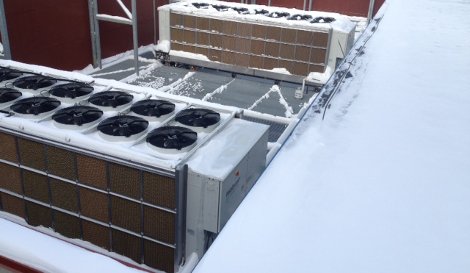While most Americans who live in areas of the country affected by this week's extreme temperature drop were caught by surprise, data center operators with facilities in these areas said the so-called “Polar Vortex” did nothing they were unprepared for.
Companies that build data centers in these areas design the buildings and the infrastructure to withstand extreme cold weather and have operating procedures in place to double-check preparedness when the temperature does drop.
“You prepare for the winter,” David Caron, senior VP of portfolio management at Digital Realty Trust, said. “You have to do it as you design the building.”
Weather forecasters on Wednesday said there were signs that the major cold snap that resulted from a region of polar weather breaking off and traveling toward the US was easing. Areas of the country affected the most were the Midwest and the Northeast.
Companies design for the climate they are in. A data center in a hurricane-prone area will be designed to withstand strong winds, and a facility in a region that sees a lot of earthquakes will have a number of earthquake-proofing features.
“In a market like Chicago you can't be surprised that there's a cold snap,” Caron said.
This does not mean that when the temperature drops below 'zero' all data center staff carries on as usual. Corey Needles, senior VP of data center operations at Latisys, which operates a data center in Chicago, said there was a number of things to take into account, especially when the temperature is negative 15F or 20F, as Chicago has seen this week.
“We have a subzero check list when it comes to cooling infrastructure,” he said.
One of the main things Latisys operations team in Chicago does when cold weather approaches is turn on the redundant free air cooling infrastructure that is located outside of the building. The backup equipment is usually off but when the temperature is below zero, liquid in the piping may freeze if it is not running.
There is antifreeze in the liquid, but when it is that cold, the liquid may “slush up,” as Needles put it.
Another important check is to make sure no breakers are tripped on the electrical system that powers trace heating along pipes. This is special tape or cabling that runs along the pipes and heats them, commonly used in all kinds of buildings to prevent pipes from freezing and cracking or to maintain constant temperature of liquid running through them.
Regular checks of all power systems are done more frequently at Latisys during extreme weather days. Another one of these checks is to make sure dual batteries and heating systems on generators are functioning.
Data center operators that bring in outside air for cooling have to be very conscious of humidity levels. Cold air is dry, and data center humidification systems may have groupble keeping up on extremely cold days.
At Latisys, operators usually supplement main humidification with small portable humidifiers to address this problem.
Another major check, done under any slightly unusual circumstances by data center operators, is emergency communications. CoreSite, another data center operator with presence in Chicago, tests its emergency communication plan on a regular basis, Jarrett Appleby, the company's COO, said.
CoreSite's operators also check that adequate supplies, such as diesel fuel, are available, and its security staff increase frequency of outside patrols, since there are fewer people outside during cold weather and there is higher risk of break-ins.

